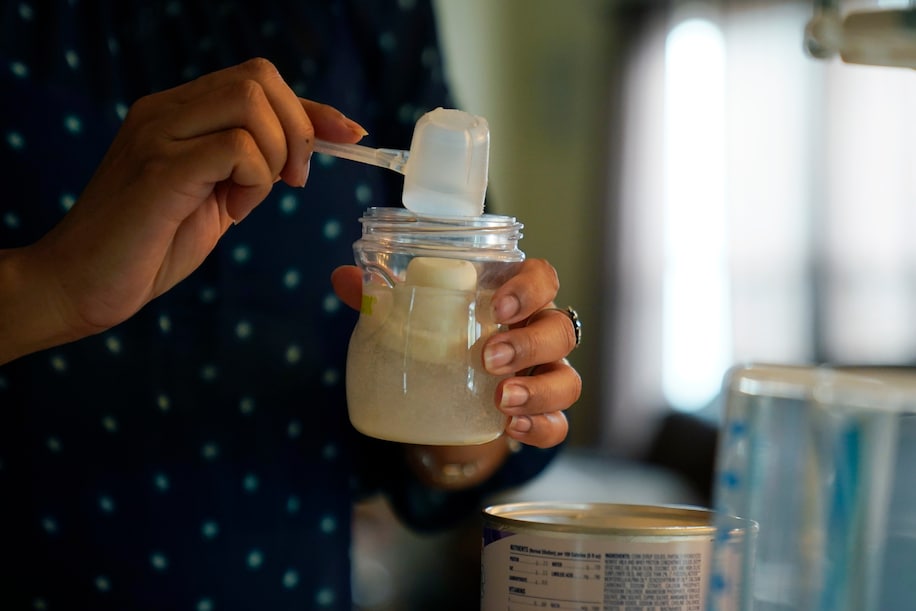Cronobacter infections are rare, but there are ways to minimize the risk further.
By Laura Reiley September 6, 2022 at 9:30 a.m. EDT

Millions of babies around the world get 100 percent of their daily nutrition from reconstituted powdered formula. Yet, experts differon what level of precaution is necessary to prepare it safely.
To kill pathogens such as Cronobacter sakazakii, the World Health Organization says to boil water, cool it to no less than 158 degrees Fahrenheit (70 Celsius) in a sterilized feeding cup or bottle, then add the exact amount of formula as instructed on the formula label. The American Association of Pediatrics says to boil and cool the water for about 5 minutes before mixing with formula when feeding it to babies under 3 months, those born prematurely and others with weak immune systems. The Centers for Disease Control and Prevention says formula “does not need to be warmed before feeding” but suggests boiling and cooling water if contamination is a concern for infants with weak immune systems or those under 2 months.
The reason for these discrepancies, said David Berger, medical director of Wholistic Pediatrics & Family Care in Tampa and an American Association of Pediatrics member, is often a matter of geography.
The fight to keep a little-known bacteria out of baby formula
“Part of this conversation is that the WHO and UNICEF are taking care of people in developing countries where there aren’t always safe water supplies,” he said. In the United States, pediatricians and feeding experts are more worried about scalding accidents or boiling water destroying some of the nutrient value of a formula’s probiotics or added vitamins.
But cronobacter in formula has occasionally sickened and killed babies in the United States. As a result, many pediatricians and food safety experts say the safest options for young and vulnerable babies is breastfeeding or giving them sterile liquid formula that comes in pre-sealed, ready-to-feed bottles from the factory.
If using powdered formula, “the key issue is this: For infants under 3 months of age, those who were born prematurely and those who have a weakened immune system, hot water should be used to prepare formula to kill any microbes,” said Steven Abrams, a doctor and professor in the Department of Pediatrics at Dell Medical School at University of Texas at Austin.
“Some groups, including the WHO, tend to choose to keep the water still hot rather than cooling. This helps kill any bacteria, like cronobacter, in the powder, but both the Food and Drug Administration and the CDC do not see this as necessary routinely, and allow the water to cool so as to decrease the risk of burns,” Abrams said.
Parents trying to find baby formula are getting scammed
Experts agree on other best practices for keeping formula — and any product fed to babies — safe.
Wash your hands before preparing a bottle, said Melissa Glassman, medical director of New York Presbyterian’s Newborn Clinic and its Outpatient Breastfeeding Support Program. She suggests washing bottles and nipples with hot soapy water every single time, leaving them on the counter to air-dry upside down in a clean space or a dedicated drying rack just for the infant feeding items, making sure that water doesn’t pool at the bottom of bottles.
She says for vulnerable babies, extra precautions can be taken and bottles and equipment can be boiled on top of the stove or run through the dishwasher in the top rack.
The Mayo Clinic says you can use any type of clean water — tap or bottled. If you’re concerned about the purity of your water supply or the condition of your pipes, many public water systems will test drinking water upon request. If you use well water, the Mayo Clinic suggests boiling it for about one minute and cooling it to body temperature (that’s 98.6 degrees Fahrenheit or 37 degrees Celsius).
Glassman said that parents are sometimes confused and think that bottled water eliminates the possibility of pathogens such as cronobacter.
What to do if you can’t find baby formula
“Parents think it’s the water, not a potential pathogen in the formula itself, so that if they use bottled water they think they’re good,” she said.
The Mayo Clinic says discard remaining formula at the end of each feeding if it has been more than an hour from the start of a feeding. Resist the urge to refrigerate a bottle once you have fed your baby from it, since bacteria from your baby’s mouth can still multiply in the refrigerator.
On the other hand, said Berger, freshly prepared bottles are good in the refrigerator for 24 hours.
“Don’t be mixing up your bottles at 3 a.m.,” he said, when caregivers might be addled and more prone to making mistakes. “You can make up eight bottles at once and keep them refrigerated, then let each one come up to room temperature.” One way to gently heat the prepared bottle is to place it into a cup or saucer of hot water.
Store unopened infant formula containers in a cool, dry, indoor place — not in vehicles, garages, or outdoors, according to the CDC. Do not store it in the refrigerator or anyplace that has significant fluctuations in temperature, like near a window or on top of a microwave, Berger said.
Most infant formulas need to be used within one month of opening the container, though caregivers should check the label. The CDC suggests that when you first open a new container, write the date on the lid to help you remember.
https://www.washingtonpost.com/business/2022/09/06/infant-formula-safety-cronobacter/
